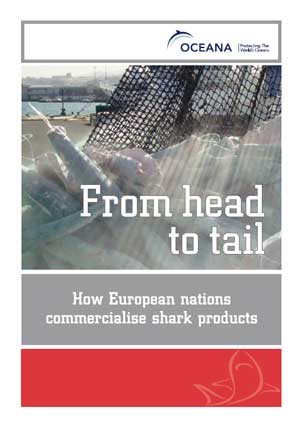Report | April, 2010
From head to tail. How European nations commercialise shark products
Sharks have been fished for hundreds of years, some records even date back to ancient Roman times. But it has only been in the last few decades when the volume of shark catches increased exponentially. Sharks are now targeted by both highly industrialised fishing fleets and artisanal fisheries.
Sharks are mainly hunted for their fins to make the traditional Chinese shark fin soup. Until the mid 1980s during the Mao Zedong and early Deng Xiaoping eras, shark fins were considered an imperial delicacy banned from Chinese dining tables or priced beyond the reach of all but the wealthiest consumers.
But as China’s tiger economy roared, so did demand for the desired shark fin soup. Classified as a “Pu” (strengthening) food, shark fin is considered to have medicinal qualities. It is the Chinese equivalent to the West’s chicken soup: good for curing the flu and strengthening general health and the immune system. Due to the fact that shark fins are much more valuable than the rest of the shark body, sharks are often “finned”. This is when a shark is hauled on deck, its fins are sliced off, and the animal – sometimes still alive – is thrown back to sea for an inevitable death. This practice is cruel and incredibly wasteful.
Oceana researchers carried out a year-long investigation into the shark fin trade, visiting harbours, shark fin traders and shark fin factories around the world. In the harbours, the shark species found to be the most important for the fin market include blue (Prionace glauca), mako (Isurus spp.), hammerheads (Sphynra spp.) and thresher (Alopias spp.) sharks.
Makos, hammerhead and threshers, which are targeted by the Spanish and Portuguese longliner fleets, are considered “threatened” according to the International Union for the Conservation of Nature (IUCN) Red List of Threatened Species.
While fins are the main reason behind the increasing worldwide hunt for sharks, there are many other shark parts used and consumed. In conjunction with the raising worldwide market for shark fins, markets for shark meat have also opened up, such as in some South American countries, like Brazil. Markets have also opened up in eastern European countries as a solution for increasing European shark catches. White-coloured shark meat is highly appreciated by European consumers and often used as a replacement for other overexploited higher-value fish. For example, in Italy, frozen blue shark steaks are sold side by side with frozen swordfish steaks. The shark steaks are cheaper and are sometimes offered as a replacement for the similar- ooking overfished swordfish. Recently, Poland has also began to acquire a taste for shark steaks, thanks to growing imports of shark meat coming directly from Spain.
Markets for shark liver oil have been in existence throughout the past century. Historically, shark liver oil was used as high-quality machine oil, but this was later replaced by synthetic products. However, shark liver oil is now used for the production of squalene, an expensive ingredient in certain cosmetic creams and lotions. Squalene is touted for increasing absorption of skin creams and lotions and preventing moisture loss. Targeted fisheries for the liver oil of deep-sea sharks have depleted several species, including Portuguese dogfish (Centroscymnus coelolepis) and leafscale gulper sharks (Centrophorus squamosus).
The demand for shark fins, meat and liver oil, and the resulting fishing pressure, has driven numerous shark species to the brink of extinction. In particular, exploiting sharks to only commercialise certain parts and not taking advantage of the entire animal is not a sustainable fishery practice. As a result, according to the IUCN Red List, about one-third of European shark and ray populations assessed are considered “threatened”.




